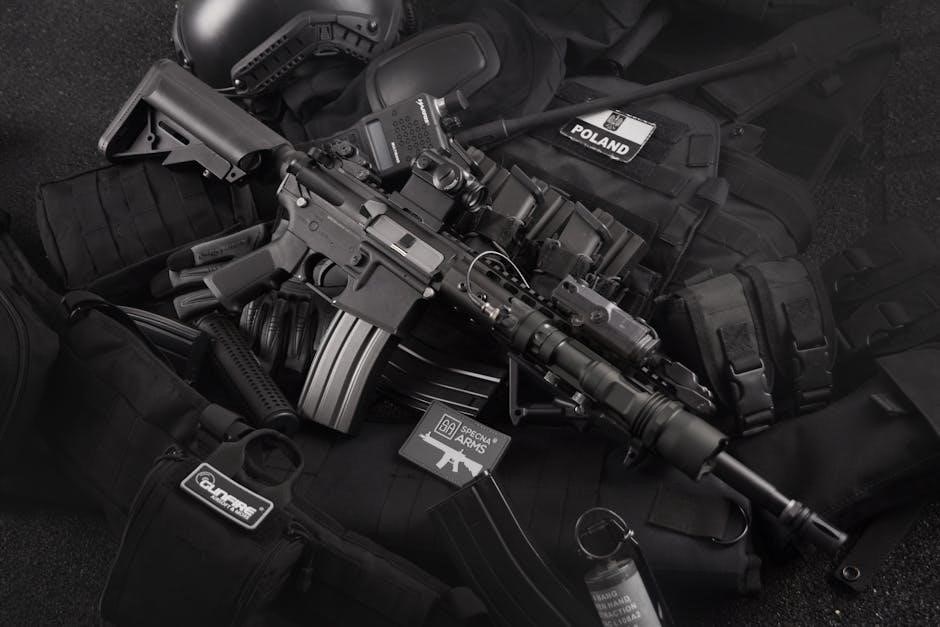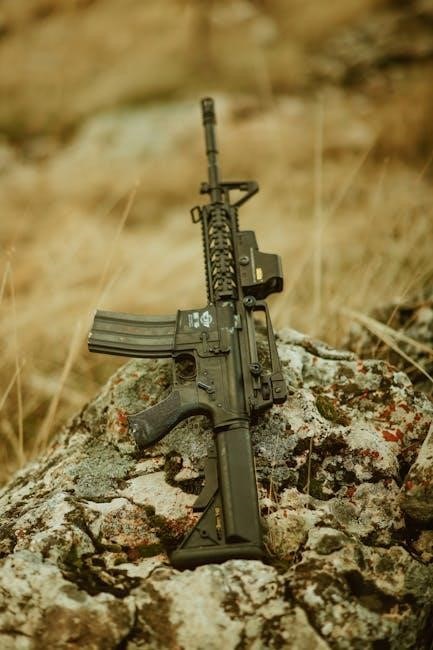Preventive Maintenance Checks and Services (PMCS) are critical for ensuring the HMMWV’s operational readiness and reliability. PMCS involves systematic inspections and maintenance tasks outlined in technical manuals like TM 9-2320-280-10 and TM 9-2320-280-34. These procedures cover daily inspections, lubrication schedules, and troubleshooting to prevent mechanical failures. Regular PMCS ensures the vehicle’s performance, safety, and longevity, making it a cornerstone of Army maintenance practices.
1.1 What is HMMWV PMCS?
HMMWV PMCS stands for Preventive Maintenance Checks and Services, a systematic process to ensure the vehicle’s optimal performance and reliability. It involves regular inspections, lubrication, and maintenance tasks as outlined in technical manuals like TM 9-2320-280-10 and TM 9-2320-280-34. PMCS includes daily checks, weekly inspections, and specific procedures for before, during, and after operations. These tasks are designed to identify and address potential issues early, ensuring the HMMWV remains operational, safe, and ready for mission requirements.
1.2 Importance of PMCS in Army Operations
PMCS is vital for maintaining operational readiness, ensuring the HMMWV’s reliability, and safeguarding crew safety. Regular maintenance prevents mechanical failures, reduces downtime, and extends the vehicle’s lifespan. It also minimizes repair costs and ensures mission success by identifying issues early. Adhering to PMCS procedures enhances overall unit readiness and contributes to the efficient execution of military operations. Properly maintained vehicles reduce risks and ensure personnel can perform their duties effectively in various operational environments.
Key Components of HMMWV PMCS
Key components include engine, transmission, brakes, axles, electrical systems, steering, and suspension. Regular checks ensure optimal performance, safety, and longevity of the vehicle.
2.1 Engine and Transmission Maintenance
Engine and transmission maintenance are vital for HMMWV performance. Checks include oil and coolant levels, belt inspections, and monitoring for leaks or unusual noises. The transmission fluid level and condition must be verified. Proper maintenance prevents overheating, wear, and mechanical failure. Adhering to TM guidelines ensures optimal engine and transmission functioning, maintaining vehicle reliability and operational readiness under various conditions;
2.2 Brake and Axle System Checks
Brake and axle system checks are essential for ensuring HMMWV safety and performance. Inspect brake pads for wear, rotors for damage, and brake fluid levels. Check axle boots for tears and ensure proper lubrication. Tighten axle bolts to specified torque values. These checks prevent brake failure and axle damage, ensuring reliable operation in demanding conditions. Regular maintenance, as outlined in TM 9-2320-280-10, is critical for maintaining vehicle integrity and operational readiness.
2.3 Electrical System and Battery Maintenance
Regular maintenance of the HMMWV’s electrical system and battery is vital for reliable operation and safety. Inspect battery terminals for cleanliness and security, and check electrolyte levels. Ensure the battery is fully charged and test it if it’s been in storage for over six months. Examine wiring and connections for damage or corrosion, and verify all lights and signals are functioning properly. Refer to TM 9-2320-280-10 for detailed procedures to ensure electrical system integrity and optimal performance.
2.4 Steering and Suspension Inspections
Inspect the HMMWV’s steering and suspension systems to ensure stability and control. Check tie rods, ball joints, and steering gear for wear or damage. Examine shock absorbers and springs for leakage or sagging. Verify proper alignment and tighten loose components. Refer to TM 9-2320-280-10 for detailed inspection procedures. Addressing issues promptly prevents vibration, loss of control, and potential accidents during operation.

Technical Manual (TM) Overview
The HMMWV’s maintenance is guided by technical manuals like TM 9-2320-280-10 (Operator’s Manual) and TM 9-2320-280-34 (Maintenance Manual). These manuals provide essential instructions for inspections, repairs, and parts replacement.
3.1 TM 9-2320-280-10: Operator’s Manual
TM 9-2320-280-10 serves as the primary guide for HMMWV operators, detailing procedures for daily PMCS checks, lubrication schedules, and operational guidelines. It provides step-by-step instructions for conducting pre-, during-, and post-operation inspections, ensuring the vehicle’s readiness for missions. The manual also includes troubleshooting tips and maintenance schedules to help operators identify and address issues early, preventing major repairs. It is an essential resource for ensuring the HMMWV’s reliability, safety, and optimal performance in various operational environments.
3.2 TM 9-2320-280-34: Direct Support and General Support Maintenance
TM 9-2320-280-34 provides detailed procedures for direct and general support maintenance of the HMMWV, targeting repair and diagnostics beyond operator-level tasks. It covers advanced troubleshooting, repair procedures, and parts replacement, ensuring vehicle functionality. This manual is essential for maintenance personnel, offering comprehensive guidelines for addressing complex issues. It complements the operator’s manual by focusing on deeper mechanical interventions, ensuring the HMMWV remains operational under demanding conditions. Regular use of this manual enhances maintenance efficiency and vehicle reliability.
PMCS Procedures
PMCS procedures ensure systematic checks and maintenance tasks are performed before, during, and after operations. These steps, outlined in technical manuals, guarantee vehicle reliability and safety.
4.1 Before Operation Checks
Before operation checks are essential to ensure the HMMWV is ready for duty. These checks include inspecting the engine oil, coolant levels, and battery condition. Tires must be checked for proper inflation and wear. Brake systems, steering components, and suspension parts are also examined for damage or leaks. Additionally, all lights, signals, and communication equipment are tested to ensure functionality. These steps, detailed in TM 9-2320-280-10, help prevent operational issues and enhance safety.
4.2 During Operation Checks
Detailed in TM 9-2320-280-10, during operation checks involve monitoring the HMMWV’s performance while in use. Soldiers should continuously assess engine performance, transmission operation, and electrical system functionality. They must also watch for signs of fluid leaks, unusual noises, or excessive heat. Tire pressure should be checked periodically, and communication equipment must remain operational. Any issues detected during operation are documented and reported to higher authorities for prompt resolution, ensuring mission continuity and safety. These checks are vital for sustaining vehicle reliability in the field.
4.3 After Operation Checks
After operation checks, as outlined in TM 9-2320-280-10, ensure the HMMWV is properly inspected post-mission. Soldiers must check for fluid leaks, coolant levels, and battery condition. Tires should be inspected for damage or wear, and brake systems must be evaluated for proper function. All findings are documented, and any issues are reported for repair. This step is crucial for identifying and addressing potential mechanical problems before they escalate, ensuring the vehicle remains operational and safe for future missions.

Lubrication and Fluids
Lubrication schedules and fluid checks are vital for HMMWV maintenance. Ensure correct lubricants are used, and fluids are at recommended levels as per TM 9-2320-280-10 specifications.
5.1 Lubrication Intervals and Specifications
Lubrication intervals for the HMMWV are detailed in TM 9-2320-280-10, ensuring optimal engine and component performance. Regular oil changes, grease applications, and fluid checks are essential. The manual specifies intervals based on operational conditions, with more frequent maintenance required in extreme environments. Adhering to these guidelines prevents wear and tear, ensuring the vehicle’s longevity and reliability during missions. Proper lubrication is critical for maintaining the HMMWV’s readiness and operational efficiency.
5.2 Fluid Levels and Condition Checks
Fluid level and condition checks are vital for maintaining the HMMWV’s operational readiness. TM 9-2320-280-10 outlines procedures for checking engine oil, coolant, transmission, and brake fluid levels. Regular inspections ensure fluids are within specified ranges and free from contamination. Operators must also monitor for signs of leakage or degradation. Adhering to these guidelines prevents mechanical failures and ensures reliable performance under various operational conditions. Proper fluid maintenance is essential for sustaining the vehicle’s functionality and longevity in the field.

Special Considerations
Special considerations include lubrication intervals, operating conditions, and compliance with TM guidelines to ensure optimal performance and longevity of the HMMWV in various environments.
6.1 Environmental Factors Affecting PMCS
Environmental factors significantly impact HMMWV PMCS. Extreme temperatures, dust, and humidity require adjusted maintenance schedules. For instance, dusty conditions demand more frequent air filter inspections, while extreme heat necessitates closer monitoring of coolant levels. Cold weather affects battery performance, requiring additional checks. Humidity can accelerate corrosion, prompting more frequent inspections of metal components. Adhering to TM guidelines ensures vehicles remain operational in diverse environments, maintaining readiness and safety for military operations. Proper adjustments prevent premature wear and potential system failures.
6.2 Accessories and Optional Equipment Maintenance
Accessories like winches, TOW launchers, and communication equipment require specific PMCS attention. Regular inspections ensure proper mounting and function. Electrical systems for accessories must be checked for connectivity and damage. Lubrication of moving parts, such as winch cables, is essential. Follow TM guidelines for maintenance intervals and procedures. Proper care extends equipment lifespan and ensures operational readiness. Neglecting accessory maintenance can lead to malfunctions, compromising mission capability. Always cross-reference with TM 9-2320-280-10 for detailed instructions.

Documentation and Reporting
Accurate documentation of PMCS is crucial for tracking maintenance history and ensuring compliance with Army standards. Reporting deficiencies promptly prevents minor issues from escalating. Technical manuals guide the process, emphasizing the importance of detailed records for accountability and future inspections.
7.1 Maintaining PMCS Records
Maintaining accurate and detailed PMCS records is essential for tracking the HMMWV’s maintenance history. These records include inspection checklists, repair logs, and parts replacement documentation. Technical manuals like TM 9-2320-280-10 and TM 9-2320-280-34 provide standardized formats for recording PMCS activities. Proper documentation ensures compliance with maintenance schedules, aids in identifying recurring issues, and supports accountability. It also serves as a reference for future maintenance actions, ensuring the vehicle remains operational and safe.
7;2 Reporting Deficiencies and Repairs
Reporting deficiencies and repairs is a critical step in the PMCS process. Any issues identified during inspections must be documented and communicated promptly. Technical manuals like TM 9-2320-280-10 and TM 9-2320-280-34 provide guidelines for reporting procedures. Deficiencies are typically recorded using standardized forms, detailing the type of issue, the individual who identified it, and the corrective actions taken. Timely reporting ensures repairs are addressed before they escalate, maintaining vehicle safety and operational readiness. This process also helps track recurring issues for long-term maintenance planning.

Training and Resources
The Army offers comprehensive training programs and resources for HMMWV PMCS, including technical manuals like TM 9-2320-280-10 and online materials to ensure mastery of maintenance procedures.
8.1 Army Training Programs for PMCS
The Army provides structured training programs to ensure soldiers master HMMWV PMCS procedures. These programs include classroom instruction and hands-on practice, emphasizing adherence to technical manuals like TM 9-2320-280-10. Training covers inspection techniques, lubrication schedules, and troubleshooting to prevent mechanical failures. Soldiers learn to identify and address issues early, ensuring vehicle readiness and safety. These programs are essential for maintaining operational efficiency and reducing downtime in field operations.
8.2 Additional Resources for HMMWV Maintenance
Beyond technical manuals, soldiers can access additional resources like PS Magazine articles and SOUMs, which provide practical solutions to common HMMWV maintenance issues. These resources often include troubleshooting tips and detailed repair procedures. Digital platforms and Army knowledge portals also offer updated guidelines and training materials. Supplementary guides, such as those for specific accessories or operational conditions, further enhance maintenance capabilities. These resources ensure comprehensive support for HMMWV upkeep and operational readiness.

Common Issues and Solutions
Common HMMWV issues include worn brake pads, fluid leaks, and electrical malfunctions. Regular PMCS inspections help identify these problems early, enabling timely repairs and preventing breakdowns.
9.1 Frequently Encountered PMCS Issues
Common PMCS issues for the HMMWV include worn brake pads, fluid leaks, and electrical system malfunctions. These problems often arise from neglecting routine inspections or failing to address minor defects. Lubrication deficiencies and improper tire pressure are also frequent issues, leading to reduced vehicle performance. Additionally, corrosion and worn suspension components can develop over time, especially in harsh environments. Identifying these issues early during PMCS inspections helps prevent costly repairs and ensures operational readiness.
9.2 Troubleshooting Tips for HMMWV Maintenance
Troubleshooting HMMWV issues begins with referencing technical manuals like TM 9-2320-280-10 and TM 9-2320-280-34 for diagnostic guidance. Check fluid levels, electrical connections, and worn parts. Use visual inspections and diagnostic tools to identify faults. Address minor issues promptly to prevent major repairs. Regularly review PMCS records to track recurring problems. Ensure all maintenance aligns with specified intervals and procedures to maintain vehicle reliability and operational readiness.
Effective HMMWV PMCS ensures vehicle reliability, safety, and readiness. Adhering to TM guidelines maximizes performance and minimizes downtime, essential for successful Army operations and maintenance efficiency.
10.1 Summary of Key Points
Regular PMCS ensures the HMMWV’s operational readiness and longevity. Adhering to TM guidelines, such as TM 9-2320-280-10 and TM 9-2320-280-34, is crucial for maintaining vehicle performance. Key tasks include daily inspections, lubrication schedules, and fluid checks. Proper documentation and timely repairs prevent minor issues from escalating. Environmental factors and special equipment require additional attention. By following these practices, soldiers can ensure their HMMWV remains reliable, safe, and mission-capable, minimizing downtime and enhancing overall operational efficiency.
10.2 Final Thoughts on Effective PMCS Practices
Effective PMCS practices are essential for maintaining the HMMWV’s reliability and safety. Consistent adherence to TM guidelines ensures optimal performance and extends vehicle lifespan. Proper documentation and timely repairs are critical for accountability and operational readiness. Neglecting PMCS can lead to costly repairs and safety hazards. By prioritizing preventive maintenance, soldiers contribute to mission success and reduce downtime. Regular training and reference to technical manuals like TM 9-2320-280-10 are vital for mastering PMCS procedures and ensuring continuous improvement.



